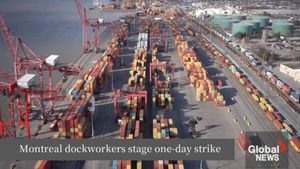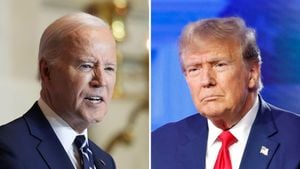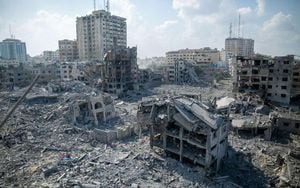Boeing's Starliner spacecraft has successfully completed its uncrewed return to Earth after undocking from the International Space Station (ISS). The spacecraft left the ISS on September 6, 2024, and landed at White Sands Space Harbor, New Mexico, just after midnight Eastern Time. The return mission marks the conclusion of what began as Boeing's first astronaut mission but transitioned to a lengthy saga of delays and technical challenges.
The undocking, which occurred autonomously at 6:04 p.m. EDT, was celebrated with enthusiasm as live commentary over the NASA stream pronounced, "OK, she's on her way home." Mark Nappi, Boeing's vice president and program manager of the Commercial Crew Program, expressed appreciation for the team's efforts to prepare for the safe return. "I want to recognize the work the Starliner teams did to assure successful and safe undocking, deorbit, re-entry, and landing," he stated.
While the Starliner succeeded on its return trip, the two astronauts, Butch Wilmore and Suni Williams, remain stranded on the ISS, with plans for their return to Earth scheduled for February 2025. Originally meant to return shortly after their arrival aboard the Starliner on June 5, their stay has extended significantly due to multiple technical issues. NASA decided it would be too risky for them to return on Starliner, leading to the arrangement for them to return on SpaceX's Crew-9 Dragon mission.
The uncrewed spacecraft was filled with cargo, including standard safety equipment, which had been stowed for their mission before reconfiguring the seats for this return trip. The astronauts engaged with various operational tasks to prepare Starliner for its return, including packing valuable station equipment for recovery on the ground. This supplemental cargo was made ready for the recovery crew to retrieve following Starliner’s landing.
Before Starliner's launch back on June 5, it experienced several delays stemming from technical difficulties, such as helium leaks and thruster failures. The spacecraft's challenges have been well documented, pushing back its mission timeline and underscoring the struggles Boeing has faced with this program compared to its competitor, SpaceX. NASA astronaut Steve Stich expressed confidence prior to the undocking, stating, "We have confidence in the vehicle... We have had two good landings so far and we are expecting another one on Friday."
Starliner's flight test included extensive planning and numerous re-evaluations of its systems, especially after some alarms and signals suggested potential issues with the capsule’s equipment, particularly during thruster tests. Technical evaluations did yield important data for engineers but also helped NASA assess potential risks tied to Starliner's reliability.
Following its launch, Starliner completed several operations as it docked with the ISS, only to be confronted with five reported helium leaks and thruster complications. Washington's decision to steer away from sending the astronauts on Starliner - which has showcased such difficulties on previous flights - highlights the challenges Boeing's team must overcome to restore trust and confidence on future missions.
NASA and Boeing have been partners since the early days of the Commercial Crew Program, which was primarily initiated to assure U.S. independence from reliance on Russian spacecraft for astronaut transport. While SpaceX has already completed several successful missions, Boeing's Starliner has yet to prove its reliability fully. NASA entrusted SpaceX as the next operator to bring back Wilmore and Williams, which serves to bolster SpaceX's growing portfolio of successful crewed missions since 2020.
Safety was the key consideration behind the decision to delay the astronauts' return on Starliner, even as Boeing continues to prepare the spacecraft for its next missions. Steps including advanced software updates and ground test performance evaluations have become standard practice as Boeing works toward certifying Starliner for routine flights to the ISS. The spacecraft itself, equipped with advanced avionics and autonomous handling capabilities, has shown promise during its autonomous handling sequences, affirming its potential for future missions.
Starliner separated its service module before conducting its deorbit burn, initiating the process required to return to Earth, where it executed several key maneuvers to facilitate re-entry. This included entering the atmosphere at high speeds where temperatures could reach as high as 3,000 degrees Fahrenheit. Boeing's engineers implemented measures such as ablative heat shields, which use plastic resin to carry heat away from the craft, keeping the interior temperatures manageable.
Upon reaching around 30,000 feet, the capsule deployed its parachutes to decelerate its descent, ensuring it landed safely and slowed to just over four miles per hour before reaching the ground. Technicians from NASA and Boeing monitored the uncrewed landing effort, confirming all systems performed as expected.
While excitement fills the air for the successful landing of the Starliner, there remain underlying challenges Boeing will have to address. The program's historical delays and the current decision to part with its crew have cast shadows over Starliner's future, highlighting the urgent need for the company to regain confidence and meet NASA's stringent safety requirements for future launches. Boeing is determined to continue pushing for the successful re-integration of Starliner missions and work toward certification for regular astronaut flights.
Moving forward, the countdown to the forthcoming SpaceX Crew-9 Dragon mission is eagerly awaited, which will usher Wilmore and Williams back home. On this mission wherein NASA jokes previously referred to as its “orbital Uber,” the anticipated transition back to Earth is expected to come with much media coverage and layered excitement for the astronauts, who remain engaged with their space station duties even during their extended stay.



